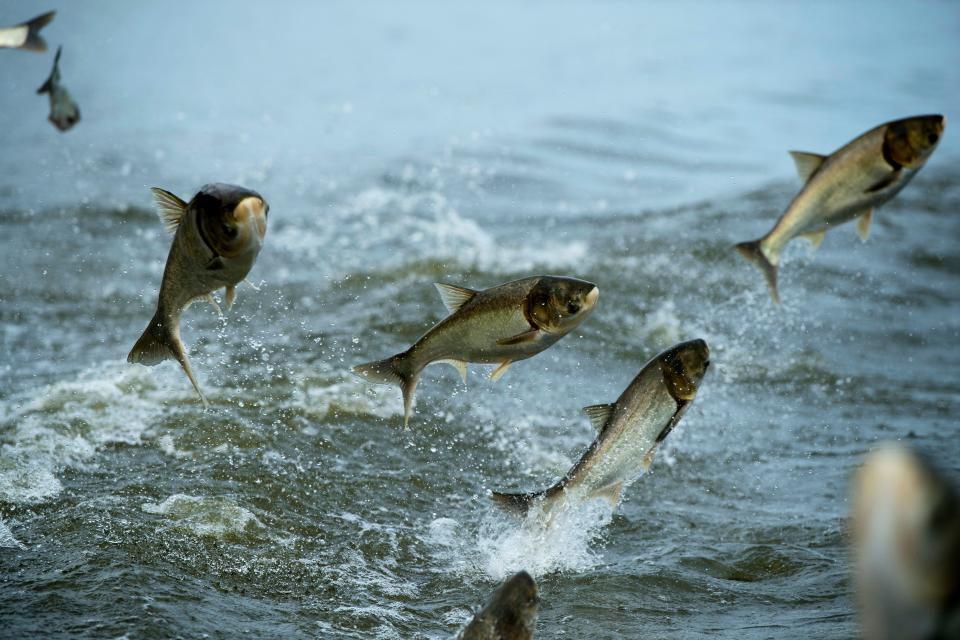Tennessee wildlife officials will pay you $100 to catch these invasive carps. What to know
The Tennessee Wildlife Resources Agency (TWRA) will pay you to fish, but only if you catch a tagged silver carp.
TWRA is running a "silver carp reward tag project" in collaboration with Kentucky Department of Fish and Wildlife Resources. In both Kentucky Lake and Lake Barkley, fisheries will tag around 1,000 silver carp with a loop tag. Some silver carp will have an upper jaw band.
Fishers can turn in tags and bands each for a $100 reward.
Through the project, TWRA studies the impact of removing silver carp populations and how biologists can fight this invasive species. Additionally, the project supplies data on the carp's movement, behavior and routes.
TWRA began a program in 2018 to eradicate carp from those lakes. In July 2021, the agency reached a milestone of removing 10 million pounds of the invasive species.
Here's what you need to know to help out and claim $100.
Where can I catch silver carp in Tennessee during this project?
Silver carp swims mostly in West and Middle Tennessee.
Reports place the fish species moving south from Kentucky Lake along the Tennessee River and branching off to the Duck and Buffalo rivers. Reports also place the silver carp upstream east from Barkley Lake along the Cumberland River. The furthest report east placed the fish at the Cordell Hull Dam.
One reported sighting was in the Chickamauga Reservoir near Chattanooga.
Silver carp can make it into East Tennessee waters, but it's uncommon. If one is caught in a location uncommon for silver carp, TWRA urges fishers to ice or freeze the fish and contact TWRA immediately.

What do I do if I catch a tagged silver carp?
First, keep the tag. The tag shows you caught the carp, it's neccesary for the reward and there's a phone number on the tag.
The second step is to call or text the listed phone number to contact TWRA's fisheries division.
Finally, fishers will need to provide additional information for the project:
Contact information for the reward
Fish identification number on the tag
A photo of the reward tag
Date of capture
Method of capture
Approximate location where it was caught
Confirm if the fish was harvested or not
Why are invasive carp bad? How many invasive carp species are there?
There are four invasive carp species in the U.S. and Tennessee. Each species originates from the Yangtze and Amur River systems in China.
Silver carp (the subject of this project) eat microscopic aglae and zooplankton. Zooplankton is a vital food source for native fish species including paddlefish, shad and buffalo. Weighing about 60 pounds, silver carp tend to jump in the water and injure boaters. This makes the species a threat to both other fish and fishers.
Bighead carp also eat zooplankton too, thinning the diet of native fish. Bighead carp are quite large, too, weighing up to 100 pounds.
Black carp eat snails and mussels. Originally, black carp was brought to the U.S. to control the snail population because snails host parasites. Now, the fish species threatens native snail populations.
Finally, grass carp eat aquatic vegetation and was introduced to specifically eat weeds in catfish ponds. However, the species eats various types of vegetation that provides cover for fish like largemouth bass, crappie and bluegill. Vegetation also provides food for waterfowl. Sterile grass carps are legal to keep in private lakes and ponds, but recently tests showed that most carp aren't sterile.
Where are the other invasive carp species found?
Bighead carp are usually found in the lower reservoirs of the Tennessee and Cumberland rivers, with a few reaching the Nickajack Reservoir.
Black carp reports locate the species primarily in the Mississippi River, but some have been found in Kentucky Lake and Barkley Lake.
Finally, the U.S. Fish and Wildlife Service works with states to manage grass carp in small lakes. Additionally, private owners stock grass carps in their lakes and ponds.
How do you deal with invasive carp?
The U.S. Geological Survey recommends fish poisons, barriers, physical removal, catching the carp, altering their habitats or adding threats to control the population.
TWRA recommends contacting the agency if an invasive carp species is located in an uncommon area.
Is carp safe to eat?
Carp is safe to eat, according to the USGS. Just be cautious of the intramuscular bones.
TWRA serves invasive carp at events throughout the year. The agency hopes people will try it and desire to eat more, which will grow demand for carp harvesting.
If you see carp on the menu or at a market, it's safe to eat.
In September 2023, the Tennessee Department of Environment and Conservation lifted a "Do Not Consume" advisory for silver and bighead carp caught in the Mississippi River.
You can't move live carp, according statewide guidelines. Silver carp, bighead carp and black carp are all banned from being moved while alive.
Keenan Thomas reports for the Knox News business growth and development team. You can reach him by email at keenan.thomas@knoxnews.com.
Support strong local journalism and unlock premium perks at knoxnews.com/subscribe.
This article originally appeared on Knoxville News Sentinel: Tennessee wildlife agency pays cash to catch invasive silver carps

